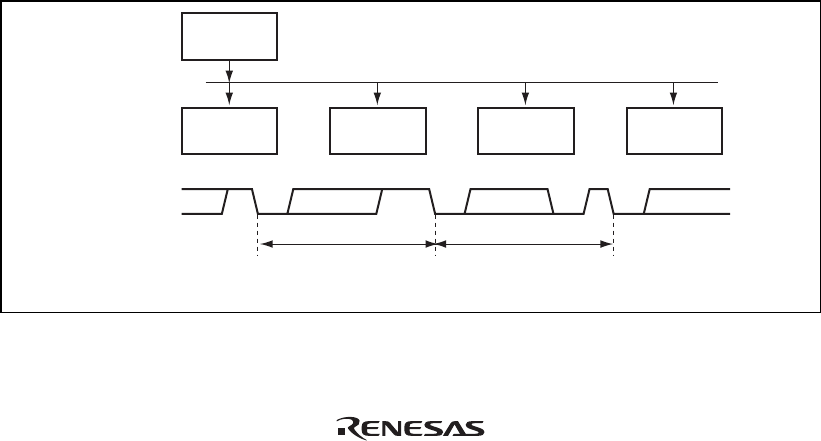
Rev. 1.00, 05/04, page 259 of 544
12.5 Multiprocessor Communication Function
Use of the multiprocessor communication function enables data transfer to be performed among a
number of processors sharing communication lines by means of asynchronous serial
communication using the multiprocessor format, in which a multiprocessor bit is added to the
transfer data. When multiprocessor communication is carried out, each receiving station is
addressed by a unique ID code. The serial communication cycle consists of two component cycles:
an ID transmission cycle which specifies the receiving station, and a data transmission cycle for
the specified receiving station. The multiprocessor bit is used to differentiate between the ID
transmission cycle and the data transmission cycle. If the multiprocessor bit is 1, the cycle is an ID
transmission cycle, and if the multiprocessor bit is 0, the cycle is a data transmission cycle. Figure
12.10 shows an example of inter-processor communication using the multiprocessor format. The
transmitting station first sends the ID code of the receiving station with which it wants to perform
serial communication as data with a 1 multiprocessor bit added. It then sends transmit data as data
with a 0 multiprocessor bit added. The receiving station skips data until data with a 1
multiprocessor bit is sent. When data with a 1 multiprocessor bit is received, the receiving station
compares that data with its own ID. The station whose ID matches then receives the data sent next.
Stations whose ID does not match continue to skip data until data with a 1 multiprocessor bit is
again received.
The SCI uses the MPIE bit in SCR to implement this function. When the MPIE bit is set to 1,
transfer of receive data from RSR to RDR, error flag detection, and setting the SSR status flags,
RDRF, FER, and ORER in SSR to 1 are prohibited until data with a 1 multiprocessor bit is
received. On reception of a receive character with a 1 multiprocessor bit, the MPB bit in SSR is set
to 1 and the MPIE bit is automatically cleared, thus normal reception is resumed. If the RIE bit in
SCR is set to 1 at this time, an RXI interrupt is generated.
When the multiprocessor format is selected, the parity bit setting is invalid. All other bit settings
are the same as those in normal asynchronous mode. The clock used for multiprocessor
communication is the same as that in normal asynchronous mode.
Transmitting
station
Receiving
station A
Receiving
station B
Receiving
station C
Receiving
station D
(ID = 01) (ID = 02) (ID = 03) (ID = 04)
Serial communication line
Serial
data
ID transmission
cycle = receiving station
specification
Data transmission cycle =
Data transmission to
receiving station specified by ID
(MPB = 1) (MPB = 0)
H'01
H'AA
[Legend]
MPB: Multiprocessor bit
Figure 12.10 Example of Communication Using Multiprocessor Format
(Transmission of Data H'AA to Receiving Station A)


















